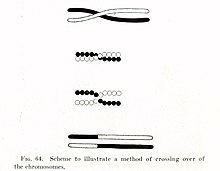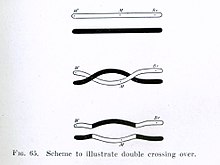
Back تعابر كروموسومي Arabic Krossinqover Azerbaijani Кросинговър Bulgarian Krosing-over BS Encreuament Catalan Crossing-over Czech Crossing-over German Entrecruzamiento cromosómico Spanish Ristsiire Estonian Elkargurutzaketa Basque



Chromosomal crossover, or crossing over, is the exchange of genetic material during sexual reproduction between two homologous chromosomes' non-sister chromatids that results in recombinant chromosomes. It is one of the final phases of genetic recombination, which occurs in the pachytene stage of prophase I of meiosis during a process called synapsis. Synapsis begins before the synaptonemal complex develops and is not completed until near the end of prophase I. Crossover usually occurs when matching regions on matching chromosomes break and then reconnect to the other chromosome.
Crossing over was described, in theory, by Thomas Hunt Morgan; the term crossover was coined by Morgan and Eleth Cattell.[3] Hunt relied on the discovery of Frans Alfons Janssens who described the phenomenon in 1909 and had called it "chiasmatypie".[4] The term chiasma is linked, if not identical, to chromosomal crossover. Morgan immediately saw the great importance of Janssens' cytological interpretation of chiasmata to the experimental results of his research on the heredity of Drosophila. The physical basis of crossing over was first demonstrated by Harriet Creighton and Barbara McClintock in 1931.[5]
The linked frequency of crossing over between two gene loci (markers) is the crossing-over value. For fixed set of genetic and environmental conditions, recombination in a particular region of a linkage structure (chromosome) tends to be constant and the same is then true for the crossing-over value which is used in the production of genetic maps.[6][7]
When Hotta et al. in 1977 compared meiotic crossing-over (recombination) in lily and mouse they concluded that diverse eukaryotes share a common pattern.[8] This finding suggested that chromosomal crossing over is a general characteristic of eukaryotic meiosis.
- ^ Griffiths AJ, Gelbart WM, Miller JH, et al. (1999). "Mitotic Crossing-Over". Modern Genetic Analysis. New York: W. H. Freeman.
- ^ Wang S, Zickler D, Kleckner N, Zhang L (1 February 2015). "Meiotic crossover patterns: obligatory crossover, interference and homeostasis in a single process". Cell Cycle. 14 (3): 305–314. doi:10.4161/15384101.2014.991185. PMC 4353236. PMID 25590558.
- ^ Morgan TH, Cattell E (1912). "Data for the study of sex-linked inheritance in Drosophila". Journal of Experimental Zoology. 13 (1): 79–101. Bibcode:1912JEZ....13...79M. doi:10.1002/jez.1400130105.
- ^ Janssens FA, Koszul R, Zickler D (June 2012). "The chiasmatype theory. A new interpretation of the maturation divisions. 1909". Genetics. 191 (2): 319–346. doi:10.1534/genetics.112.139725. PMC 3374304. PMID 22701051.
- ^ Creighton HB, McClintock B (August 1931). "A Correlation of Cytological and Genetical Crossing-Over in Zea Mays". Proceedings of the National Academy of Sciences of the United States of America. 17 (8): 492–497. Bibcode:1931PNAS...17..492C. doi:10.1073/pnas.17.8.492. PMC 1076098. PMID 16587654. (Original paper)
- ^ Rieger R, Michaelis A, Green MM (1976). Glossary of genetics and cytogenetics: Classical and molecular. Heidelberg – New York: Springer-Verlag. ISBN 978-3-540-07668-1.
- ^ King RC, Stransfield WD (1998). Dictionary of genetics. New York & Oxford: Oxford University Press. ISBN 0-19-50944-1-7. ISBN 0-19-509442-5.
- ^ Hotta Y, Chandley AC, Stern H (September 1977). "Meiotic crossing-over in lily and mouse". Nature. 269 (5625): 240–242. Bibcode:1977Natur.269..240H. doi:10.1038/269240a0. PMID 593319. S2CID 4268089.